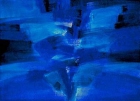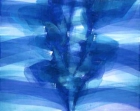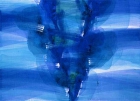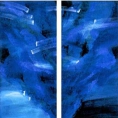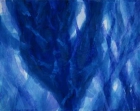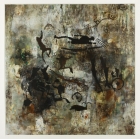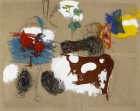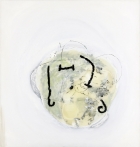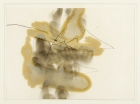
Artist | Goto Kazuko (*1941)
https://www.artist-info.com/artist/Goto-Kazuko
Biography
Biography
1941 Born in Harpin,Manchuria
1963 Graduated from Hokkaido University of liberal Arts
Solo Exhibitions
Solo Exhibitions
1973 Daimaru Gallery,Sapporo
1975 Sapporo Tokeidai Gallery,Sapporo ('77,'79,'83,'86,'89 )
1987 Kwan Hun Gallery,Seoul,Korea
1989 Gallery Center Point,Tokyo ('90,'92,'94 )
1992 Gallery Ai,Sapporo
1993 Creo Gallery,Sapporo
1996 Gallery Yamaguchi,Tokyo ('98 )
1997 Klarisky Church,Bratislava,Slovakia
1997 Saloon Gallry DORAL,Sapporo
Group Exhibitions
Group Exhibitions
1980 Contemporary Artists Exhibition in Hokkaido, Hokkaido Museum of Modern Art, Sapporo ('81,'82, )
1981 ART TODAY SAPPORO TRIENNALE 1981, Hokkaido Museum of Modern Art, Sapporo ( '84,'87 )
1983 Selected Exhibition of Image Hokkaido, Hokkaido Museum of Modern Art, Sapporo ('84,'87,'88 )
1985 PAN PACIFIC ART EXHIBITION IN SEOUL 1985, Fine Art Center, Seoul, Korea
1985 Japan-Korea in Canada '85, Artcite Gallery, Windsor, Canada
1989 DAIMARU GALLERY AND ARTISTS, Daimaru Fujii Central Sky Hall, Sapporo
1989 Sapporo-America Contemporary Art Exchange, American Center, Sapporo
1990 THE EYE DOES HEAR, Creo Gallery, Sapporo
1991 From Island to Island, Japan-Korea Print Exchange, Cheju Cultural Center, Cheju, Korea
1992 From Island to Island, Japan-Korea Print Exchange, Daido Gallery, Sapporo
1992 Seoul-Sapporo Art Show, Seoul Metropolitan Museum of Art, Seoul, Korea
1994 NORTHERN CREATERS, Museum of Contemporary, Sapporo
1994 Northern Tide:Avant-garde, Art From Hokkaido, Hokkaido Museum of Modern Art, Sapporo
1996 My Sight, Continental Gallery, Sapporo
1998 New Collections, Hokkaido Museum of Modern Art, Sapporo
Public Collections
Public Collections
Hokkaido Museum of Modern Art, Sapporo
About the work (english)
About the work (english)
Pilgrimage For " Water" --In the Case of Kazuko Goto--
The series of paintings by Kazuko Goto appear to me as the history of her own struggle to express "water", that is, not water per se, but an evasive, water-like entity. This artist, who works in Hokkaido, seems to have a long career; however, I have no knowledge of her works prior to her exhibition of `89, when she began holding private exhibitions in Tokyo every few years under this general theme. Each time, I have observed that she has approached the enigmatic entity from different angles.
"Water" represents something beyond a superficial object for drawing; it is the evasive, ever-changing, water-like entity which she has been trying to grasp. The "blue" is predominant both in the titles and in the works themselves; however, it is nothing more than a mere manifestation on the surface level. If one tries to get to the core of it, "water" will evade and shuns being the means of expression or even being the theme for one's work. (For the expression of "water", please refer to my essay, "The Reality of Water in Modern Age" in the catalog for the exhibition titled "Water and Man" held at Ibaraki Prefectural Art Museum, 1995). In most of the works with this theme of "water", either the artists assume that they have captured the essence by temporarily arresting it as a solid object, or drawing something else, merely creating a scab-like formation on top of it. In either case, they have become cliche. Although "water" is omnipresent, if one tries to look at it itself, it would only puzzle one. When one thinks that one is looking at it, one is merely looking through it and seeing something else. Water is shapeless. Because of its highly fluid nature it will go into containers of any shape; it evaporates, freezes and changes its appearanc from moment to moment. If the shape is an attribute of the solid matter, can one grasp "water" with plastic art--creating forms of it?
Many artists have felt compelled to draw "water", but faced extreme difficulties grasping it. Kazuko Goto's works reveal that her attempts to capture it from many different perspectives have also been trying. Perhaps, the process of this struggle has been a way to discipline her own painting.
Before this series involving "water", Goto was trying to depict with Liquitex (acrylic) organic forms which were metaphoric of the mystery or essence of the universe. At the exposition in `89, a work titled SHOKU (Corrosion of Borderlines) was displayed. The work consisted of three to four pieces of paper suspended without frames, executed in india ink and water-soluble acrylic. The work had brush strokes leaving an untouched background in the centre, which demanded attention for its own shape, an objet d' art in its own right. However, as I stated earlier, "water" has no shape, and, by nature, it has nothing to do with the centre as such. Pieces of paper as supporting bodies were suspended in an effort to dilute its own identity. The struggle between the two elements, namely, the drawing and the background, was sought, but the shape took precedence. The question here seems to be one of how deep can an artist lower the plumb line into something beyond the physical realm that is between the empty background and the shape.
At the next exposition, the work titled SO (Overlapping Strata) no longer had the shape. Although pieces of paper overlapped at its edges, crisscrossing large brush strokes gave a continuity between the pieces; the background behind the painting was resplendent, shining through the mesh. The awareness of the supporting body had shifted from one of a place on which ideas and representations are loaded to one that shows the act and process of depiction. By simplification of large brush strokes, an attempt is made to be linked, as a whole, to something larger than shape. However, the artist went too deep for a proper perspective, bringing on monotony in an enclosed space.
In the work titled YO (Swing), I found a stylized expression of the sparkle on the water surface and the movements of the wave which were alluded in the earlier work. The elements depicted abstractly in SO are now swinging toward more concrete expression.
Perhaps because of reflection on the decorative and explanatory approach, in the following year, in the work under the same title, Goto removes herself from the direct representation of "water"; she allowed the stronger say-so of the painting in the struggle of brush strokes. Arcs fly from left and right, leaving the tracks of the act of painting. Gradually, brush strokes leave a fan-shaped, translucent paddle in the centre. A shape made of very fine mesh has been woven. There is not a hint of a direct approach to "water" here. I might say that the artist has detached herself from "water", avoiding an explanation of the attributes of "water". What emerges here are the features of water-soluble paint--its seeping and bluring quality-- which are projected onto the paper, a sort of screen. Here we can trace the act of painting itself.
In YO, the artist gives a certain distance from plastic art, conscious of its own category of expression, namely painting. Certainly she is not after an image or shape, but after an entity vague in its nature such as feelings or allusions of something beyond. A background in the shape of a weaver's shuttle that was seen in the middle of SHOKU of `89 can be seen again--this time upright--behind the brush strokes.
At the beginning of her attempts, she derived a shape from a conflict between drawing and background (`89); then, she approached the reality of "water" very close in an attempt to to be united to it (`90); after that, she went through a phase of more direct and concrete portrayal (`92); and finally, there was a reflection and a reaction to this previous concrete expression--the artist tries to keep the centre while moving away from concreteness (`94). When the whole of what she has been trying to accomplish is seen, one finds that the path she has trodden is one of an upward spiral.
Finally, we come to the newest YO, (the author has not seen the actual painting yet.) It is more complex than any of her works we have observed here. However, the basic colour of blue, the paint, and the Japanese hand-molded paper are consistent elements from the earlier works. The four to six painted papers--some of them are different in size--will be overlapped at some parts. The painting shows diversity in style, from the usual simple and clear large brush strokes to very repetitious and heavy brush strokes. Each piece has an expression of its own. The centre as such has vanished and the continuum among the pieces has given way to a contrast, giving up the monolithic image. The centre that functioned as a magnetic field has been abandoned, making the depicted space uniform. The supporting bodies that had become fragmented because of unique expression given to each piece are now suspended as a reflective existence as a whole. Ultimately, what Goto is trying to do can be summed up as an intentional disturbance of the equilibrium: she is attempting to introduce an accident to avoid harmonie preetablie which comes about inevitably as a consequence of repeated strokes on the large surface. It is not just the contrasting effect of a painting technique, but it should be an attempt to create an intellectual system after the manifestation of the gaps in the paintings. Just think of the seven-colour spectrum contiguous to the loose, expressive picture of Tabuchi Yasuichi. Our artist goes beyond the painting that "retires" as a picture of good taste. Goto's stance for the struggle with "water" is nothing but the endeavour of weaving the mesh in pursuit of the evasive reality. Only then, "water" will cease to be the object of drawing and reveal an aspect of its contemporary reality. At that moment, the perspective and stance of the artist will differ from the present one. I am curious how the paper will take such expression.
Kazuo Amano, Curator at O Art Museum
Translated by Takashi Oda
Internet
Internet
homepage of Goto Kazuko
e-mail: kazuko@mb.snowman.ne.jp
 offers / Requests offers / Requests  |
About this service |
|---|
 Exhibition Announcements Exhibition Announcements  |
About this service |
|---|
 Visualization |
Learn more about this service | ||
|---|---|---|---|

Interested in discovering more of this artist's networks?
3 easy steps: Register, buy a package for a visualization, select the artist.
See examples how visualization looks like for an artist, a curator, or an exhibition place: Gallery, museum, non-profit place, or collector.

Exhibition History

|
SUMMARY based on artist-info records. More details and Visualizing Art Networks on demand. Venue types: Gallery / Museum / Non-Profit / Collector |
||||||||||||
| Exhibitions in artist-info | 9 (S 2/ G 7) |
Did show together with - Top 5 of 56 artists (no. of shows) - all shows - Top 100
|
||||||||||
| Exhibitions by type | 9: 8 / 1 / 0 / 0 | |||||||||||
| Venues by type | 6: 5 / 1 / 0 / 0 | |||||||||||
| Curators | 1 | |||||||||||
| artist-info records | Jul 1973 - Sep 2000 | |||||||||||
|
Countries - Top 2 of 2 United States (7) Japan (2) |
Cities 2 - Top of 2 New York (7) Tokyo (2) |
Venues (no. of shows )
Top 5 of 6
|
||||||||||
Curators (no. of shows)
Top 1 of 1
|
| Gallery Onetwentyeight | G | Sep 2000 - Sep 2000 | New York | (35) | +0 | |
| Gallery Onetwentyeight | G | Nov 1999 - Nov 1999 | New York | (35) | +0 | |
| Gallery Center Point | S | Sep 1998 - Dec 1998 | Tokyo | (1) | +0 | |
| Gallery Onetwentyeight | G | Feb 1998 - Mar 1998 | New York | (35) | +0 | |
| Cast Iron Gallery | G | Jun 1997 - Aug 1997 | New York | (79) | +0 | |
| Gallery Onetwentyeight | G | Jan 1997 - Jan 1997 | New York | (35) | +0 | |
| Keep reading |











